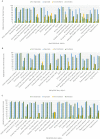Procedural Skills Training in Emergency Medicine Physicians Within the Edmonton Zone: A Needs Assessment
- PMID: 33842810
- PMCID: PMC8019211
- DOI: 10.1002/aet2.10495
Procedural Skills Training in Emergency Medicine Physicians Within the Edmonton Zone: A Needs Assessment
Abstract
Objectives: The objectives were to describe the current procedural skill practices, attitudes toward procedural skill competency, and the role for educational skills training sessions among emergency medicine (EM) physicians within a geographic health zone.
Methods: This is a multicenter descriptive cross-sectional survey of all EM physicians working at 12 emergency departments (EDs) within the Edmonton Zone in 2019. Survey items addressed current procedural skill performance frequency; perceived importance and confidence; current methods to maintain competence; barriers and facilitating factors to participation in a curriculum; preferred teaching methods; and desired frequency of practice for each procedural skill.
Results: Survey response rate was 53.6%. Variability in frequency of performed procedures was seen across the type of hospital sites. For the majority of skills, there was a significantly positive correlation between the frequency at which a skill was performed and the perceived confidence performing said skill. There was inconsistency and no significant correlation with perceived importance, perceived confidence or frequency performing a given skill, and the desired frequency of training for that skill. Course availability (76.2%) and time (72.8%) are the most common identified barriers to participation in procedural skills training.
Conclusions: This study summarized the current ED procedural skill practices among EM physicians in the Edmonton Zone and attitudes toward an educational curriculum for procedural skill competency. This represents a step toward targeted continuing professional development in staff physicians.
© 2020 by the Society for Academic Emergency Medicine.
Figures

References
-
- Farion K, Morrison LJ. Redefining emergency medicine procedures: Canadian competence and frequency survey. Acad Emerg Med 2001;8:731–8. - PubMed
-
- Royal College of Physicians and Surgeons of Canada . Objectives of Training in the Specialty of Emergency Medicine. Ottawa: The Royal College of Physicians and Surgeons of Canada, 2014.
-
- Nettleman MD, Bock MJ, Nelson AP, Fieselmann J. Impact of procedure‐related complications on patient outcome on a general medicine service. J Gen Intern Med 1994;9:66–70. - PubMed
-
- Leape LL, Brennan TA, Laird N, et al. The nature of adverse events in hospitalized patients: results of the Harvard medical practice study II. N Engl J Med 1991;324:377–84. - PubMed
LinkOut - more resources
Full Text Sources

